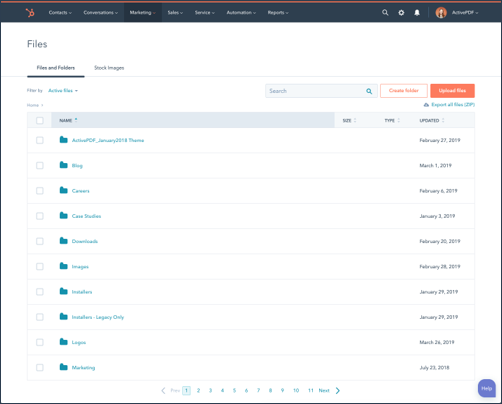1. Why Should You Organize Your Website Assets?
Having an organized Content Management System (CMS) is like having an organized desk. It helps you to do your job better and more efficiently. Here, in part one, you will learn how to organize your website assets in the HubSpot CMS. You will get an overview of the different ways to organize assets, how content status works in HubSpot, and how to use the file manager. In the second part of this blog post, you will see an example of an organized CMS from a HubSpot customer, ActivePDF.
"Organization helps you focus on your priorities and goals. Without organization, it will be difficult for HubSpot users to manage their own content and complete their goals in the long-term."
Thomas Piserchia, Agency M-1 Intern, https://www.linkedin.com/in/thomas-piserchia-02572216a/
Please consider following Agency M-1 on these Social Media platforms.
This blog post was authored by Rachel Sheldon (LinkedIn - Twitter).
With an organized desk, as you go through your day, you know where all your tools are because everything has its place, and you can easily grab what you need when you need it. There are similar benefits with an organized CMS.

Disorganization can have a negative impact on your productivity. Consider the desk analogy: If your desk is disorganized, you might spend 30 minutes searching for a piece of paper, just to discover that you actually threw it away last week. This can have a negative impact on your productivity. Keeping your CMS organized makes it more manageable and helps you to do your job more efficiently.

Advantages of Maintaining an Organized CMS
- It makes it easier to find what you need and make changes quickly.
- It makes it easier to keep your website up-to-date and relevant.
- It makes it easier to collaborate with your team.
- It makes it easier to report on your website’s performance.
Let’s examine these four key advantages in a little more depth.
1.1 An organized CMS makes it easier to find what you need and make changes quickly.
When you have an organized CMS, you don’t need to waste time searching through hundreds of files or pages to find the one you need. Keeping assets organized makes them easily accessible, which helps boost productivity.
1.2 Maintaining an organized CMS makes it easier to keep your website up-to-date and relevant.
There will be a time when you need to quickly make updates to your website, whether that’s replacing a broken link or swapping an image. When everything you need is at your fingertips, this process will be smoother and less stressful.
1.3 An organized CMS makes it easier to collaborate with your team.
When you have a clear system that everyone follows, every person can find what they need without having to ask for help. So even if you have several people creating content or uploading files, a unified system will maintain order. This is also useful if you ever outsource any work, such as development or content creation.
1.4 An organized CMS makes it easier to report on your website’s performance.
When your website assets are properly managed, the process of creating reports and pulling data can go much quicker.
Organizing your CMS requires some planning up front, but putting in this time now will save you even more time and energy in the long run.
2. How To Organize Website Assets In HubSpot
There are several ways to organize your website assets in the HubSpot CMS. First, set naming conventions for your CMS assets. This will establish consistency and make things easier to find. How you decide to name your files is up to you — you can choose to group them by product, by different parts of your business, by date, or by another factor entirely.
Guidelines for establishing naming conventions:
- The names should be descriptive
- You and your team should agree on a single system
- Stick to the system
Imagine the circumstances in which you would need to find an asset. What words would you use to search for it? Going through this mental exercise will help determine what naming structure will be most useful for you.
Once you have decided on a system, maintain it throughout your entire CMS. This includes your pages, blogs, files, CTAs, forms, and templates. If you are working with a CMS developer, it is a good idea to establish a system for naming templates.
If you’re using products from the marketplace, both the folder structure and names will be determined by the template provider. But if you have a system that works for you, you can rename and restructure marketplace assets to fit within it.
2.1 Using folders for CMS organization
Use folders wherever they are available. In the HubSpot CMS, you can create folders in the file manager, design tools, forms tool, and landing pages tool. There are also built-in folders in the website and landing page tools and the blogging tool which organize your content by status.
Use folders to visualize the status of your entire website at a glance and easily access assets in different states.
2.2 Content statuses in HubSpot CMS
There are five main content statuses in the HubSpot CMS:
- Draft
- Scheduled
- Published
- Unpublished
- Archived
Drafts: Draft content is your works in progress that is not live yet.
Scheduled: Scheduled content is content that you have finished writing and have scheduled to be published at a later date.
Published: Published content is content that is live on the web.
Unpublished: When you unpublish live, published content, it is removed from the web and reverted to draft status.
Archived: When you archive content, the content is moved to your “Archived” folder. Archiving is not the same as unpublishing – but the two concepts do work hand in hand.

If you want to take content down from the internet and archive it, you will want to both archive and unpublish it. Use the “archive and unpublish” feature to clean up your website by taking down old or outdated content. These could be landing pages for expired offers, product pages for products you no longer sell, or event pages for events that have passed.
This will not only help keep your website up to date, but it’ll also keep your CMS organized and easier to manage.
Just make sure that you set up a redirect from the page you’ve taken down to a live URL — you do not want any 404 errors on your site. Here you can learn how to redirect URLs or pages.
Another important feature in the CMS is cloning. Cloning is a feature where you can create a duplicate version of almost any asset in HubSpot. This helps cut down on content creation time. For example, if you have a page whose structure and style you like, you can clone it and swap out the content instead of having to build a new page from scratch.
But your CMS can quickly get out of control if you continue cloning assets without being fully aware of the scope of what you’re doing.
When you clone an asset, HubSpot creates a duplicate draft version of it and adds the word “Clone” at the end of the original name. For example, if I clone a landing page called “Inbound Webinar Sign-Up Page” it will create a new draft page, exactly the same as the original but called “Inbound Webinar Sign-Up Page (Clone)”.
You can change this name before it’s created. Give the new asset a new, unique name that follows the naming conventions you have set for your CMS. This will help keep your CMS organized from the start since you avoid having to go back and rename assets after they have been created.
3. How To Use The File Manager In HubSpot
The file manager is a cloud-based file storage system, similar to Google Drive or Dropbox, but built into HubSpot. It supports most file types and sizes.
Navigate to the file manager in the HubSpot CMS by clicking on Marketing in the main menu, hovering over Files and Templates, and selecting Files.
Once inside the file manager, there are several options for what you can do. Create new folders to house your files by selecting “Create folder”. To upload a new file, select “Upload file”. You also have the option to upload files in bulk.
If you need to move a file into a new folder, hover over the file and select “Move.” You can then choose where you want to move the file to by selecting a folder in the dialog box.
Another option is renaming files. Hover over the file and select “Rename.” Then, enter the new name for your file and click “Rename.”
When you click on a file in the file manager, a screen with the file details and more options will appear on the right. Here, you can see a preview of the file, when it was last updated, its dimensions and size, the file URL, and where that file is currently being used in your HubSpot CMS. This is a useful feature for seeing where exactly your files are being used on your website.
At the bottom of this screen, you also have the option to replace or clone and edit the file. Click the More button, and you will see the options to download, archive, or delete that file.

One last feature of the file manager is stock images. Click on the Stock Images tab to open the Shutterstock HubSpot integration. Here, you can search for thousands of professional stock images and download them directly to HubSpot. Here you can learn more about using stock images in your HubSpot content with the Shutterstock integration.
4. What Does An Organized HubSpot CMS Look Like?
Here’s an example of an organized CMS from a HubSpot customer. ActivePDF began using the HubSpot portals in 2017. From the start, their goal was to keep their system clean and organized.
To accomplish this, the team at ActivePDF was purposeful and proactive. They established a clear system for naming all their assets in the HubSpot system.

“The naming conventions that have been implemented in our system are truly tied in across every single aspect of the menu that you can explore across HubSpot. So, all the way from our website pages, our landing pages, our calls-to-action, our forms, our files — everything from start to finish is properly labeled and coded.” - Derek
Taking extra time in the beginning to establish a naming system saved ActivePDF hours of work in the long run. By creating a good infrastructure, it was possible to immediately respond to issues and make changes with confidence. Read more about organizing and managing assets in the next part of this blog series.
Take time to review other blog posts on this topic:
Consider taking this HubSpot course to learn the fundamentals of business analytics, managing and visualizing data, and aligning teams around data to make better business decisions.
“Students who join Agency M-1 gain invaluable insight working with real businesses to gain hands-on experience before leaving school. They build connections with executives in the business community and, in many cases, set the path for the beginning of a rewarding digital career.”
-- Brian Meek
Please consider following our student organization, Agency M-1, on Social Media.
Also, enhance your LinkedIn profile as you gain skills and then apply them in a micro-internship! Learn how!


 Rachel Sheldon
Rachel Sheldon
